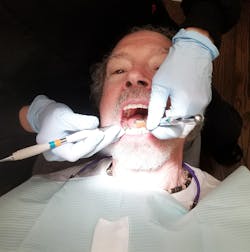Membership plans—A coverage solution for your retiring baby boomer patients
Your baby boomer patients are probably your best patients. Chances are they have been with you for many years and have been loyal and compliant. But here’s a startling fact: 10,000 boomers retire each day, and with that transition, most lose their company-sponsored benefits, including medical, dental, and vision coverage.
Retiring boomers are searching for a dental coverage solution
Boomers are the generation that created and supported the modern dentistry model as we know it. They understand that oral health is critical to overall health, they visit their dental practice twice a year, and they brush twice a day. This is a large segment of the population that truly values oral care and wants to continue with dental coverage after retirement.
The first step most boomers who are seeking coverage take is searching the web for “dental coverage for Medicare patients.” What they quickly learn is that Medicare includes a dental exclusion, wherein routine dental checkups are not covered. Neither are cleanings, fillings, crowns, implants, dentures, or tooth extractions. Medicare will pay only for certain dental services during hospitalization, leaving retired boomers with a coverage gap to fill with dental insurance, a discount plan, or paying for dental care out of pocket.
At this point, boomers will research dental insurance and discount plans from the major carriers. These plans highlight steep discounts and access to hundreds of thousands of providers. At first blush, the plans appear to meet their needs. But it doesn’t take long to notice the dreaded fine print. What should be a very simple evaluation of price and value turns into a complicated, confusing, and frustrating exercise. They may find themselves asking:
- Why is the agreement 15 pages long?
- Why are there so many exclusions?
- What is an annual maximum, and how do I know when I’ve reached it?
- Why do I have to pay a deductible when I’m already paying a large premium?
- Will I get my money’s worth?
They’re left wondering why they can’t purchase coverage that is affordable and does not require a PhD to understand.
Dental insurance and discount plans do not work for dentists or patients
The truth is that insurers control everything about the dental care market: Access. Treatment. Pricing. Payment. As a result, insurance companies have created expensive and overly complicated plans that work for them but not for dentists or patients.
Dentists must work through unnecessary hassles and constraints—payment processing delays, claims denials, treatment restrictions, declining reimbursements, and benefit coordination. Patients are forced to choose between going without coverage or paying too much for a dental plan they don’t understand. The result? Dentists can’t provide the best care to their patients and they struggle to run a successful practice, and patients can’t get access to the care they need.
Dental membership plans are an excellent coverage solution for retired boomers and your practice
Clearly, getting the insurance middlemen out of the way would make things better for your practice and boomer patients. In fact, removing third-party interference would help more than just your boomer patients. It would enable you and all of your patients to work directly together, removing the hassles and costs of insurance, and determining the best treatment plan for each patient’s needs.
Implementing a dental membership plan for your practice can be your first step in establishing freedom from insurers and enabling your patients to access simple, affordable, personalized dental coverage that enables them to commit to your practice and the care they need. With membership plans, dentists control the subscription price, procedure fees, and all plan exclusions and options. There are no deductibles, annual maximums, treatment preapprovals, waiting periods, exclusions for preexisting conditions, or other hassles. Dentists and patients are free to select the type and timing of care. And patient payments are made directly to you. There are no reimbursement paperwork, claims delays, or claims denials.
Also, you can design and price your practice’s plan based on the needs of your office and patients. For example, your membership plan can include a preventive care plan tailored to the needs of boomers, with monthly payments that fit a fixed-income budget and discounts at the specialists they need. Boomers can get the care they want to maintain good oral health within a simple coverage plan that is easy to understand and budget.
Here are some best practices for implementing a membership plan.
- Offer a variety of care plans to meet the needs of different patients—children, adults, baby boomers, or perio patients.
- Price the plan based on local economic and competitive dynamics.
- Include discounts at specialists your patients need.
- Make it easy for patients to sign up from any device.
- Establish a method for easily adding family members.
- Offer a monthly payment option.
- Automate the annual renewal process.
- Promote your plan across multiple channels, including email, print, and social media.
- Ensure compliance with federal and state regulations.
DAVE MONAHAN is CEO of Kleer. Monahan’s advocation for subscription-based dental care led to the founding of Kleer in 2016. Kleer is liberating dental care by empowering dentists to offer simple, affordable, and personalized care directly to their patients, with no insurance middlemen in the way. Kleer is turnkey and free to implement and includes everything a practice needs to create and manage a successful membership plan. For questions about membership plans powered by Kleer, visit kleer.com.
About the Author
Dave Monahan
Dave Monahan is CEO of Kleer, a leading provider of subscription-based dental care. He can be reached at [email protected].
